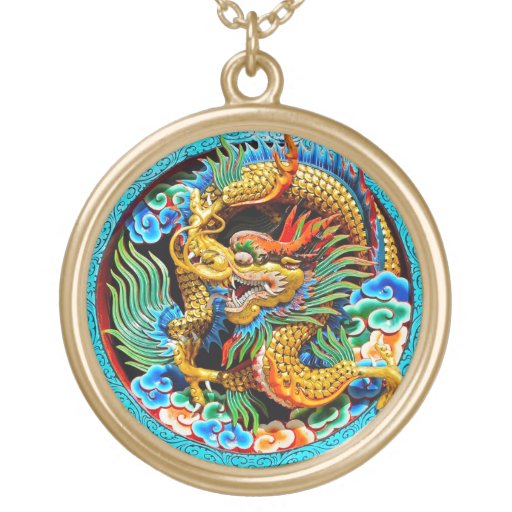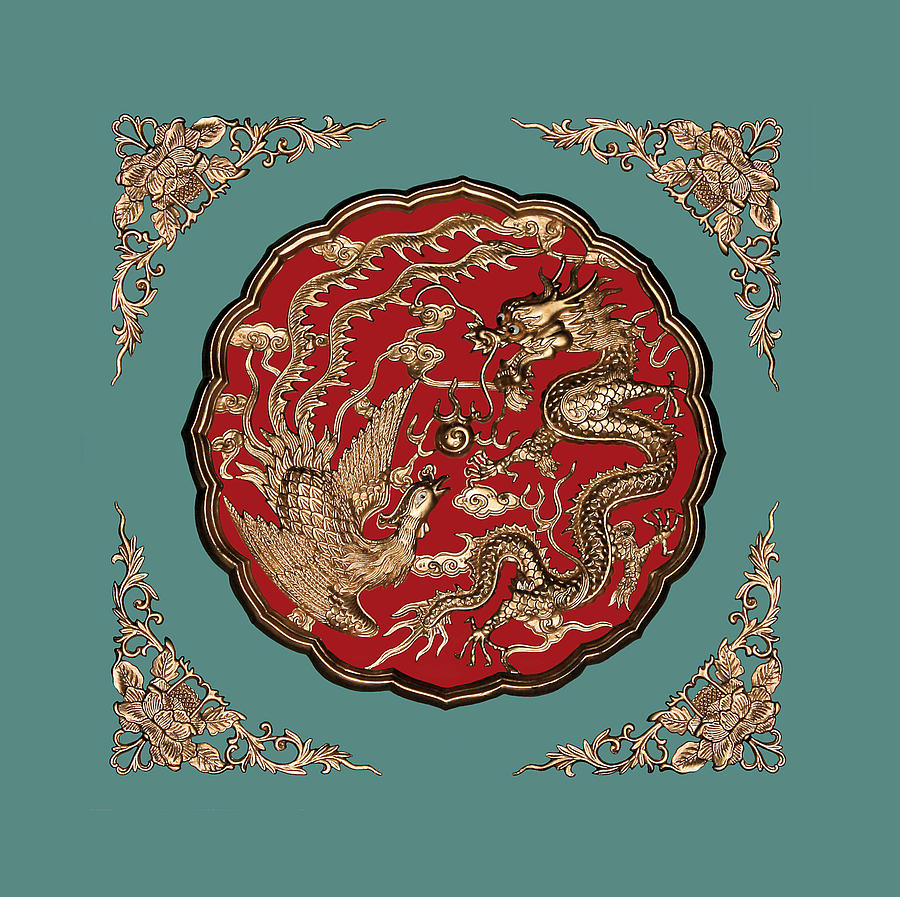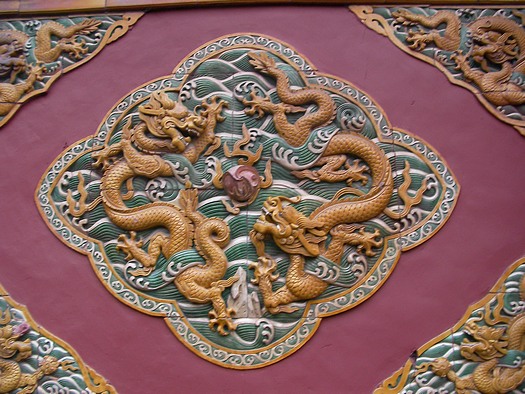Ancient Chinese Dragon Art Biography
Source(google.com.pk)
Dragons are deeply rooted in Chinese culture. In fact, the Chinese often consider themselves "descendants of the dragon."
Nobody really knows where the dragon came from. But it looks like a combination of many animals. For the Chinese people, dragons were described visually as a composite of parts from nine animals: the horns of a deer, head of a camel, eyes of the devil, neck of a snake, abdomen of a large cockle, scales of a carp, claws of an eagle, paws of a tiger and ears of an ox.
In China, the dragon is credited with having great powers that allowed it to make rain and control floods by striking the river with its mighty tail, for example. Dragons are also revered for their ability to transport humans to the celestial realms after death. They are symbols of the natural world, adaptability and transformation. When two dragons are placed together in opposite directions, they symbolize eternity, i.e., the famous Yin-Yang symbol.
Dragon robe worn by Emperor Kangxi of the Qing Dynasty
Chinese emperors thought they were the real dragons and sons of heaven. Thus, the beds they slept on are called "dragon beds;" the throne, a "dragon seat;" and the emperor's ceremonial dresses are known as "dragon robes."
In the minds of the early Chinese people, the dragon was a god that embodied the will and ideals of the Chinese people. It is said that the dragon is a large-scaled reptile, which can become dark or bright, large or small, long or short, and fly into the sky in the spring and live underwater in the fall. It seems that the dragon is capable of doing almost anything. Traditionally, the dragons were considered the governors of rainfalls in Chinese culture: They had the power to decide where and when it would rain. They also believed kings of water dragons lived in dragon palaces under the ocean. The Chinese sign for the dragon appeared during the Yin and Shang dynasties (16th-11th century BC -- the period of the earliest Chinese hieroglyphs), between inscriptions on bones and turtle shields. The inscriptions depicted a horned reptile, with teeth, scales and sometimes even claws.
In ancient China nobody had any doubt about the existence of dragons. People showed great respect for any depictions of dragons -- in paintings, carvings and writings. As a result, the dragon became the symbol of the Chinese nation. All people in China, including the emperor, prostrated themselves before the image of a dragon with reverence and awe. As a result, this fictional creature became the spiritual sustenance for the nation first as the totem of a tribe and then as the symbol of the nation. Eventually, the dragon became the symbol on the national flag of the last feudal dynasty, the Qing Dynasty. The Chinese people considered themselves the descendants of the dragon.
As the emblem of the emperor and imperial command, the legend of the Chinese dragon permeates the ancient Chinese civilization and has shaped its culture. Its benevolence signifies greatness, goodness and blessings.
The Chinese dragon symbolizes power and excellence, valiancy and boldness, heroism and perseverance, nobility and divinity. A dragon overcomes obstacles to achieve success. He is energetic, decisive, optimistic, intelligent and ambitious.
Unlike the evil energies associated with Western dragons, most Eastern dragons are beautiful, friendly and wise. They are the angels of the Orient. Instead of being hated, they are loved and worshipped. Temples and shrines have been built to honor dragons since they control the rain, rivers, lakes and seas. Many Chinese cities have pagodas where people used to burn incense and pray to dragons. The Black Dragon Pool Chapel near Beijing was reserved for the Empress and her court.
Special worshipping ceremonies took place there on the first and 15th day of every month. Dragon shrines and altars can still be seen in many parts of the Far East. They are usually located along seashores and riverbanks since it was believed that most Eastern dragons lived in water. The Isle of the Temple in Japan's Inland Sea has become a famous stopover for pilgrims who pray to the dragon. They believe that both male and female dragons have mated with humans.
Everything connected with Eastern dragons is blessed. The Year of the Dragon, which takes place ever 12 years, is considered lucky. Present-day Oriental astrologers claim that children born during Dragon Year enjoy health, wealth and long lives.
The Dragon brings the essence of life in the form of its celestial breath, known to many as "Sheng Chi." It yields life and bestows its power in the form of the seasons, bringing water from rain, warmth from the sunshine, wind from the seas and soil from the earth. The Dragon is the ultimate representation of the forces of nature. It is the greatest divine force on earth.
The Chinese dragon is often seen as a symbol of divine protection and vigilance. It is regarded as the Supreme Being among all creatures. Apart from its ability to live in the sea, fly up to the heavens and coil up on land in the form of mountains, the divine mythical animal can ward off wandering evil spirits, protect the innocent and bestow safety to all who carry its emblem. The Chinese dragon is regarded as the ultimate symbol of good fortune.
Dragon People
Personality traits of people born in the Year of the Dragon: A "dragon person" is self confident and impulsive and consequently does not always listen to the advice of others. He or she is also a perfectionist and sets high standards for him/herself. Although strong and decisive, the dragon is not manipulative or sly. He or she refuses to deceive or compromise and fails to spot subversive intents. He or she enjoys being in command and, like a good emperor, he or she eliminates obstacles until success is achieved.
WOODEN DRAGON: The Wooden Dragon is creative, imaginative and inquisitive. He or she is both a thinker and a doer and capable of brilliant new concepts. His or her every move is guided by sound logic. His or her drive and ambition allows him/her to put many of his/her ideas into practice. Nevertheless this dragon is capable of concealing his/her domination and tries not to offend anyone. He/she will even compromise if it is advantageous to him/her. Although not as self-centered as other dragons, the Wooden Dragon is still outspoken and fearless when challenged.
FIRE DRAGON: The Fire Dragon is the most extroverted and competitive dragon. He/she tends to push too hard and expects a lot from everyone. His/her criticisms are objective and he/she has the ability to arouse massive popular support. His/her insatiable ambition can make him/her short-tempered and intolerant. He/she is an empire builder who needs to master his/her less favorable traits and learn how to communicate more humbly with people as individuals.
EARTH DRAGON: The Earth Dragon is a quieter, more reflective dragon. He/she will be appreciative of other people's opinions even if he/she fails to agree with them. He/she is reasonable in his/her approach to problems and his/her leadership is less dictatorial. He/she is not prone to outbursts, but, at the same time demands respect. He/she knows the value of cooperation and is more diplomatic than other dragons. He/she is ambitious, but his/her initiatives are less hurried and more carefully thought out.
METAL DRAGON: The Metal Dragon is the most strong-willed dragon. He/she is inflexible, unbending and combative. He/she gives little regard to the feelings of others. This ruthlessness can result in a rapid rise to a position of authority, but often at the cost of destroying important relationships. It is futile to attempt to convince the metal dragon that certain things are simply unfeasible. He/she will go it alone if he/she cannot gain support. He/she succeeds because he/she refuses to accept failure.
WATER DRAGON: The Water Dragon is less selfish and opinionated than the other dragons. He/she is more inhibited and less power-hungry. He/she can accept defeat without recriminations. The Water Dragon makes a good negotiator since he/she knows when, where and how to apply pressure. He/she has a tendency to be over-optimistic and needs to learn how to relinquish what is unfeasible so that he/she can concentrate his/her energies on the most rewarding endeavors.
Types of Dragons
There are nine major types of Chinese dragons. They include the horned dragon, the winged dragon, the celestial dragon (which supports and protects the mansions of the gods), the spiritual dragon (which generates wind and rain for the benefit of mankind), the dragon of hidden treasures (which keeps guard over concealed wealth), the coiled dragon (which lives in water) and the yellow dragon (which once emerged from water and presented the legendary Emperor Fu Shi with the elements for writing).
The last of the nine is the dragon king, which actually consists of four separate dragons, each ruling over one of the four seas -- the east, south, west and north sea.
The most powerful, generalized type of Chinese dragon is the horned dragon, or lung, which can produce rain and is completely deaf. Additionally, there is a homeless dragon ("Ii") that lives in the ocean and another type ("Chiao") that is scaly and usually inhabits marshes, but also has dens in the mountains.
There are also nine ways the Chinese have traditionally represented these dragons, each one revealing a different dragon characteristic. There are dragons carved on tops of bells and gongs due to the beast's habit of shrieking when attacked.
A second type is carved on the screws of fiddles since most dragons are fond of music.
A third is carved on tops of stone tablets because of dragons' love of literature.
A fourth is found at the bottom of stone monuments since dragons can support heavy weights.
A fifth is placed on the eaves of temples since dragons are always alert to danger.
A sixth appears on the beams of bridges since dragons are fond of water.
A seventh is carved on Buddha's throne since dragons like to rest.
An eighth is placed on the hilts of swords since dragons are also capable of killing.
The ninth is carved on prison gates since such dragons are fond of quarreling and trouble-making.
The colors of Chinese dragons are evidently quite varied, but in the case of the Chiao, its back is striped with green, its sides are yellow, and it is crimson underneath.
The nine major characteristics of a lung-type dragon include a camel-like head, deer-like horns, hare-like eyes, bull-like ears, an iguana-like neck, a frog-like belly, carp-like scales, tiger-like paws and eagle-like claws. It has a pair of large canine teeth and long, tendril-like whiskers extending from either side of its mouth probably used for feeling its way along the bottom of muddy ponds.
In color, dragons vary from greenish to golden, with a series of alternating short and long spines extending down their backs and along their tails, where they become longer. One specimen had wings on its sides and walked on water. Another tossed its mane back and forth, which sounded like a flute.
Ancient Chinese Dragon Art Chinese Dragon Tattoo Head Dance Symbol Drawing Pictures Parade Costume Mask Images

Ancient Chinese Dragon Art Chinese Dragon Tattoo Head Dance Symbol Drawing Pictures Parade Costume Mask Images

Ancient Chinese Dragon Art Chinese Dragon Tattoo Head Dance Symbol Drawing Pictures Parade Costume Mask Images

Ancient Chinese Dragon Art Chinese Dragon Tattoo Head Dance Symbol Drawing Pictures Parade Costume Mask Images

Ancient Chinese Dragon Art Chinese Dragon Tattoo Head Dance Symbol Drawing Pictures Parade Costume Mask Images

Ancient Chinese Dragon Art Chinese Dragon Tattoo Head Dance Symbol Drawing Pictures Parade Costume Mask Images
Ancient Chinese Dragon Art Chinese Dragon Tattoo Head Dance Symbol Drawing Pictures Parade Costume Mask Images

Ancient Chinese Dragon Art Chinese Dragon Tattoo Head Dance Symbol Drawing Pictures Parade Costume Mask Images

Ancient Chinese Dragon Art Chinese Dragon Tattoo Head Dance Symbol Drawing Pictures Parade Costume Mask Images

Ancient Chinese Dragon Art Chinese Dragon Tattoo Head Dance Symbol Drawing Pictures Parade Costume Mask Images

Ancient Chinese Dragon Art Chinese Dragon Tattoo Head Dance Symbol Drawing Pictures Parade Costume Mask Images
No comments:
Post a Comment